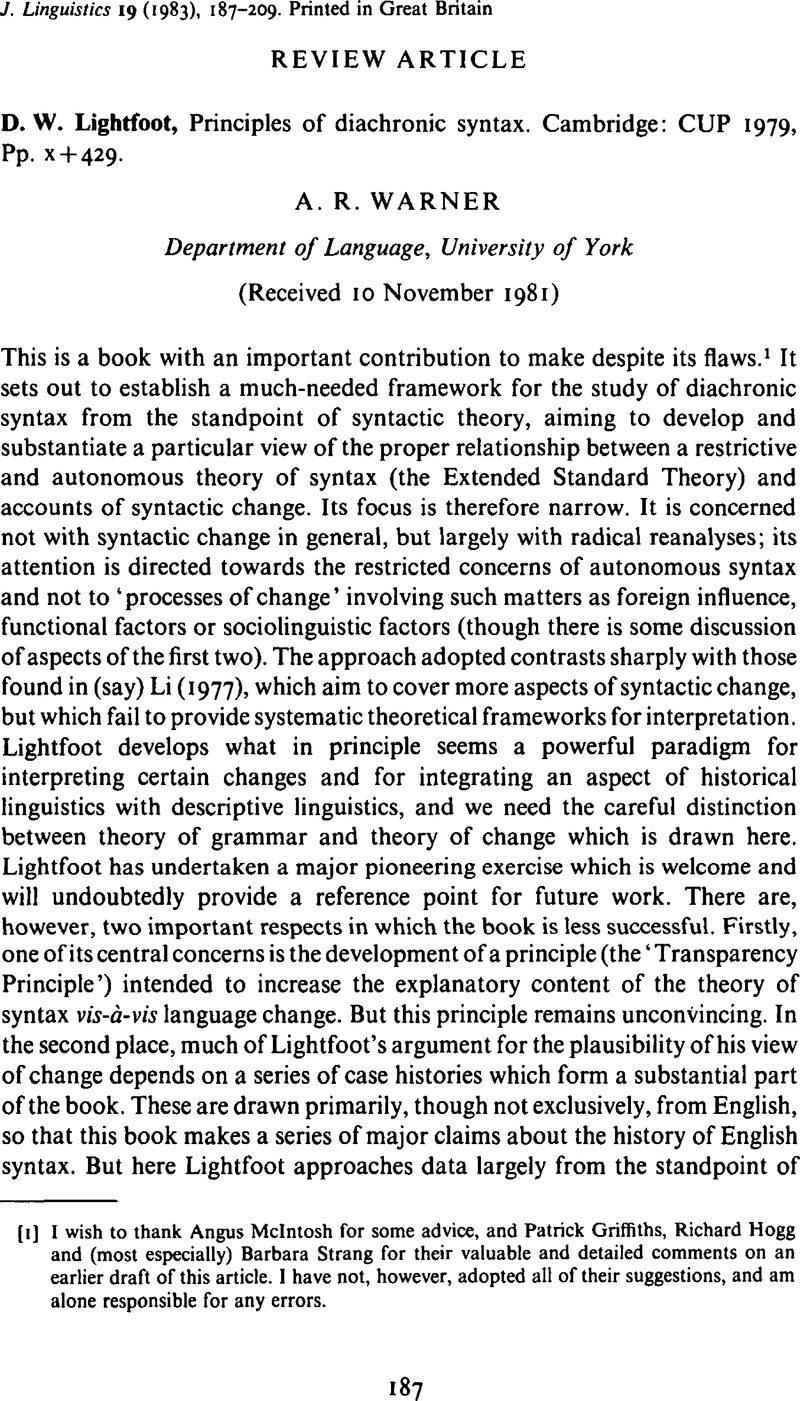Crossref Citations
This article has been cited by the following publications. This list is generated based on data provided by Crossref.
Freidin, Robin
and
Quicoli, A. Carlos
1989.
Zero-stimulation for parameter setting.
Behavioral and Brain Sciences,
Vol. 12,
Issue. 2,
p.
338.
Grodzinsky, Yosef
1989.
The language learner: A trigger-happy kid?.
Behavioral and Brain Sciences,
Vol. 12,
Issue. 2,
p.
342.
Wilkins, Wendy
1989.
Why degree-0?.
Behavioral and Brain Sciences,
Vol. 12,
Issue. 2,
p.
362.
Grimshaw, Allen D.
1989.
Infinitely nested Chinese “black boxes”: Linguists and the search for Universal (innate) Grammar.
Behavioral and Brain Sciences,
Vol. 12,
Issue. 2,
p.
339.
Lightfoot, David
1989.
The child's trigger experience: Degree-0 learnability.
Behavioral and Brain Sciences,
Vol. 12,
Issue. 2,
p.
321.
Kroch, Anthony
1989.
Language learning and language change.
Behavioral and Brain Sciences,
Vol. 12,
Issue. 2,
p.
348.
Joshi, Aravind K.
1989.
A possible mathematical specification of “degree-0” or “degree-0 plus a little” learnability.
Behavioral and Brain Sciences,
Vol. 12,
Issue. 2,
p.
345.
Stabler, Edward P.
1989.
What's a trigger?.
Behavioral and Brain Sciences,
Vol. 12,
Issue. 2,
p.
358.
Grimshaw, Jane
and
Pinker, Steven
1989.
Positive and negative evidence in language acquistion.
Behavioral and Brain Sciences,
Vol. 12,
Issue. 2,
p.
341.
Rizzi, Luigi
1989.
On the format for parameters.
Behavioral and Brain Sciences,
Vol. 12,
Issue. 2,
p.
355.
Lasnik, Howard
1989.
The nature of triggering data.
Behavioral and Brain Sciences,
Vol. 12,
Issue. 2,
p.
349.
McCawley, James D.
1989.
INFL', Spec, and other fabulous beasts.
Behavioral and Brain Sciences,
Vol. 12,
Issue. 2,
p.
350.
Morgan, James L.
1989.
Learnability considerations and the nature of trigger experiences in language acquisition.
Behavioral and Brain Sciences,
Vol. 12,
Issue. 2,
p.
352.
Snow, Catherine E.
and
Tomasello, Michael
1989.
Data on language input: Incomprehensible omission indeed!.
Behavioral and Brain Sciences,
Vol. 12,
Issue. 2,
p.
357.
Buckingham, Hugh W.
1989.
On triggers.
Behavioral and Brain Sciences,
Vol. 12,
Issue. 2,
p.
335.
Kroch, Anthony S.
1989.
Reflexes of grammar in patterns of language change.
Language Variation and Change,
Vol. 1,
Issue. 3,
p.
199.
Clark, Robin
1989.
Causality and parameter setting.
Behavioral and Brain Sciences,
Vol. 12,
Issue. 2,
p.
337.
Williams, Edwin
1989.
Linguistic variation and learnability.
Behavioral and Brain Sciences,
Vol. 12,
Issue. 2,
p.
363.
Lightfoot, David W.
1989.
Newton to Aristotle.
p.
245.
Cinque, Guglielmo
1989.
Parameter setting in “instantaneous” and real-time acquisition.
Behavioral and Brain Sciences,
Vol. 12,
Issue. 2,
p.
336.





